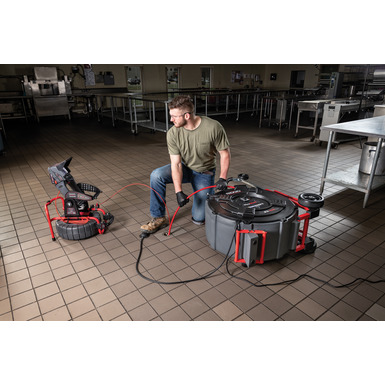

A flexible shaft is a precisely defined and configured nested group of springs, tightly wound so that it has torsional, or rotational strength, as opposed to the tensile strength found in standard wire rope or cable.
What makes flexible shafts useful for drain cleaning is that they can bend, but also still rotate. In other words, a flexible shaft transmits rotary motion much like a solid shaft, but it can be routed over, under, and around obstacles that would make using a solid shaft impractical.
Flexible shafts are used in several applications, including advanced aerospace technologies. Their flexibility, combined with tensile strength, makes flexible shafts a force in the tight, twisted environments often encountered in drain cleaning.
When compared to other drain cleaning technologies, drain cleaning machines using flexible shafts are advantageous in that they are smaller, lighter, and more flexible; easier to clean; and enable the use of a camera in drain cleaning.
These characteristics are helpful in two ways. First, the low weight and size are useful primarily for the operators of drain cleaning machines in using and transporting the equipment to the job site. The cables traditionally used in drain cleaning can be large and heavy, as well as difficult to transport. In addition, traditional drain cleaning cables, which more or less resemble extremely long, tightly wound open springs, are not very flexible. This can make maneuvering the cables through drains difficult. However, flexible shafts can be useful in applications in which the clogged pipes are particularly bendy or hard to navigate with the stiffer traditional cables.
Another advantage flexible shafts have over traditional drain cleaning cables is that they are exceedingly easy to clean. Traditional cables are like large hollow springs — and springs are open to the air, so as the cable moves through the dirty drain, unclogging debris, that debris becomes lodged in the cable. Being that these cables are long and tightly wound, it’s a hassle to maintain them and keep them clean. Flexible shafts, on the other hand, are covered in a protective casing, making cleanup after use much easier.
Lastly, flexible shafts can be advantageous to use over other drain cleaning methods in certain situations because they clean drains without water, which enables the use of a camera. When hydro-jetting, camera use is impossible due to the high volume of pressurized water used. Cleaning a drain using a machine based around a flexible shaft (or other dry cables) allows a camera to be fed into the drain just behind the spinning end of the cable. This can be helpful, as it allows you to see what exactly is blocking the pipe, enabling you to adjust your cleaning method if need be.
One example of flexible shafts being used in drain cleaning to great effect is their use by Clog Squad, a Michigan-based drain cleaning contractor. According to Clog Squad, it had been searching for a lighter, safer, and easier way to clean drains and found it in the flexible shaft.
The Ridgid Flex-Shaft drain cleaning machine is based around the use of a flexible shaft to clean drains, and the use of flexible shafts with the Ridgid has made the job cleaner, safer, and much more effective.
Ridgid uses flexible shafts from S.S. White Technologies. The manufacturer ensures that its flexible shafts are always designed to exact specifications using proprietary software. The use of these flexible shafts has enabled Ridgid great success while drain cleaning.
All three main methods for drain cleaning have a place in various applications. Now, it’s clear that flexible shafts are a light, powerful, clean, and effective new method of cleaning drains that can serve as an excellent option in all kinds of industrial drain cleaning applications.